Analysis of Theories, Principles, and Models in Education and Training
VerifiedAdded on 2020/07/22
|16
|5544
|124
Report
AI Summary
This report provides a detailed exploration of theories, principles, and models within education and training. It begins by analyzing various learning theories, including behaviorism, social learning, and cognitive learning, and discusses their application to teaching, learning, and assessment. The report then delves into communication theories, principles, and models, emphasizing their significance in the teaching-learning process. It also examines assessment theories, providing examples of assessments that improve learning, and explores curriculum development theories and models. Furthermore, the report analyzes theories and models of reflection and evaluation, offering insights into how reflective practices can enhance teaching effectiveness. Overall, the report offers a comprehensive understanding of key concepts in education and training, supported by relevant examples and analysis.
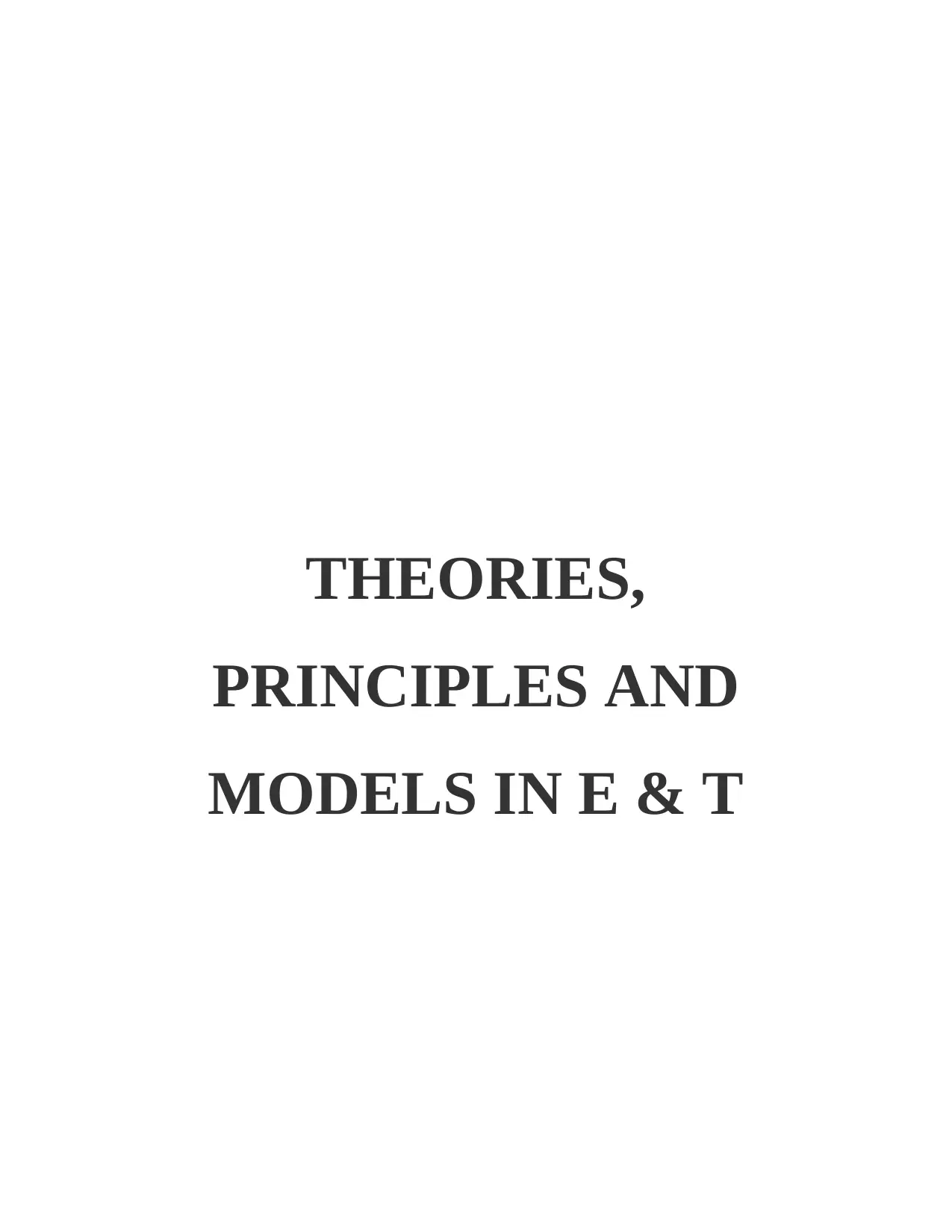
THEORIES,
PRINCIPLES AND
MODELS IN E & T
PRINCIPLES AND
MODELS IN E & T
Paraphrase This Document
Need a fresh take? Get an instant paraphrase of this document with our AI Paraphraser
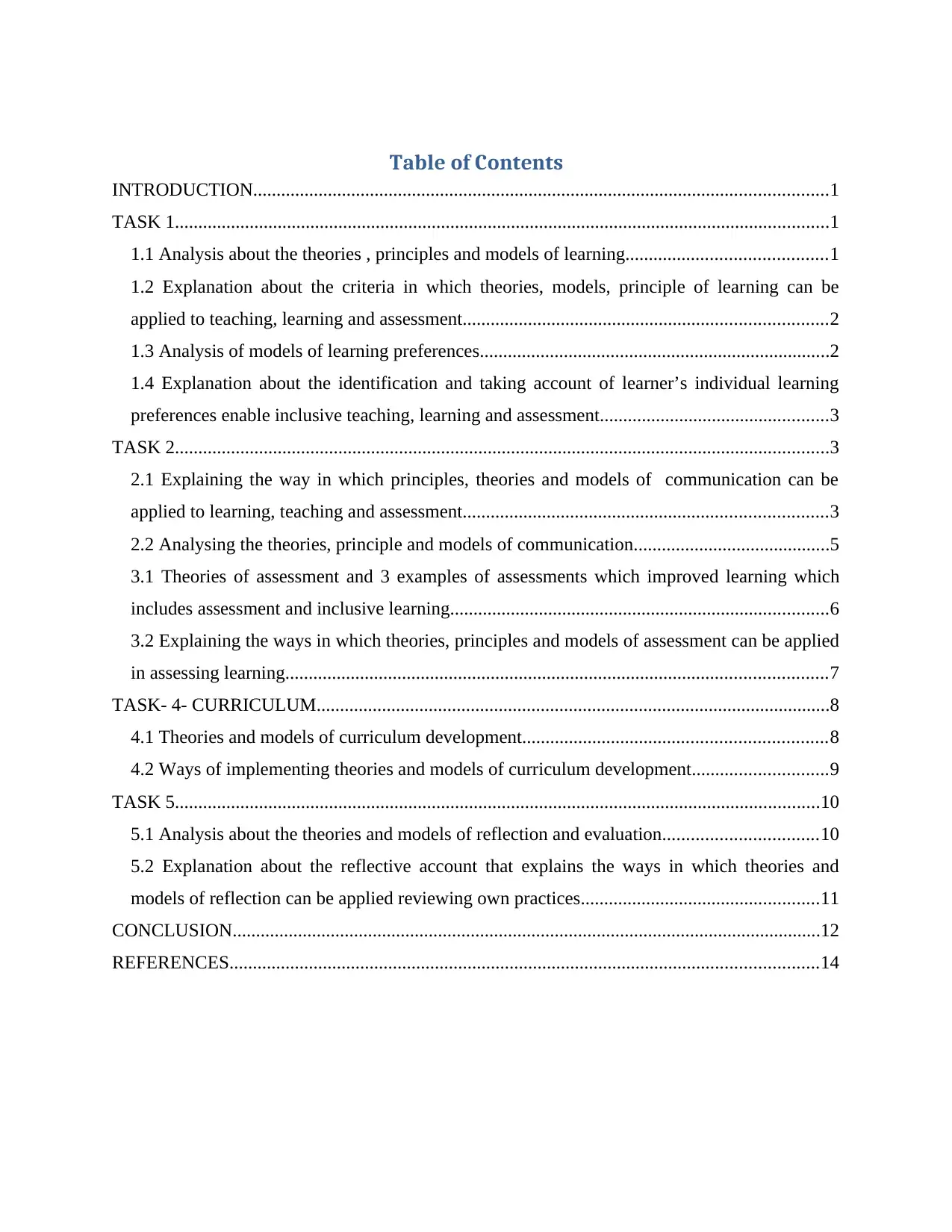
Table of Contents
INTRODUCTION...........................................................................................................................1
TASK 1............................................................................................................................................1
1.1 Analysis about the theories , principles and models of learning...........................................1
1.2 Explanation about the criteria in which theories, models, principle of learning can be
applied to teaching, learning and assessment..............................................................................2
1.3 Analysis of models of learning preferences...........................................................................2
1.4 Explanation about the identification and taking account of learner’s individual learning
preferences enable inclusive teaching, learning and assessment.................................................3
TASK 2............................................................................................................................................3
2.1 Explaining the way in which principles, theories and models of communication can be
applied to learning, teaching and assessment..............................................................................3
2.2 Analysing the theories, principle and models of communication..........................................5
3.1 Theories of assessment and 3 examples of assessments which improved learning which
includes assessment and inclusive learning.................................................................................6
3.2 Explaining the ways in which theories, principles and models of assessment can be applied
in assessing learning....................................................................................................................7
TASK- 4- CURRICULUM..............................................................................................................8
4.1 Theories and models of curriculum development.................................................................8
4.2 Ways of implementing theories and models of curriculum development.............................9
TASK 5..........................................................................................................................................10
5.1 Analysis about the theories and models of reflection and evaluation.................................10
5.2 Explanation about the reflective account that explains the ways in which theories and
models of reflection can be applied reviewing own practices...................................................11
CONCLUSION..............................................................................................................................12
REFERENCES..............................................................................................................................14
INTRODUCTION...........................................................................................................................1
TASK 1............................................................................................................................................1
1.1 Analysis about the theories , principles and models of learning...........................................1
1.2 Explanation about the criteria in which theories, models, principle of learning can be
applied to teaching, learning and assessment..............................................................................2
1.3 Analysis of models of learning preferences...........................................................................2
1.4 Explanation about the identification and taking account of learner’s individual learning
preferences enable inclusive teaching, learning and assessment.................................................3
TASK 2............................................................................................................................................3
2.1 Explaining the way in which principles, theories and models of communication can be
applied to learning, teaching and assessment..............................................................................3
2.2 Analysing the theories, principle and models of communication..........................................5
3.1 Theories of assessment and 3 examples of assessments which improved learning which
includes assessment and inclusive learning.................................................................................6
3.2 Explaining the ways in which theories, principles and models of assessment can be applied
in assessing learning....................................................................................................................7
TASK- 4- CURRICULUM..............................................................................................................8
4.1 Theories and models of curriculum development.................................................................8
4.2 Ways of implementing theories and models of curriculum development.............................9
TASK 5..........................................................................................................................................10
5.1 Analysis about the theories and models of reflection and evaluation.................................10
5.2 Explanation about the reflective account that explains the ways in which theories and
models of reflection can be applied reviewing own practices...................................................11
CONCLUSION..............................................................................................................................12
REFERENCES..............................................................................................................................14
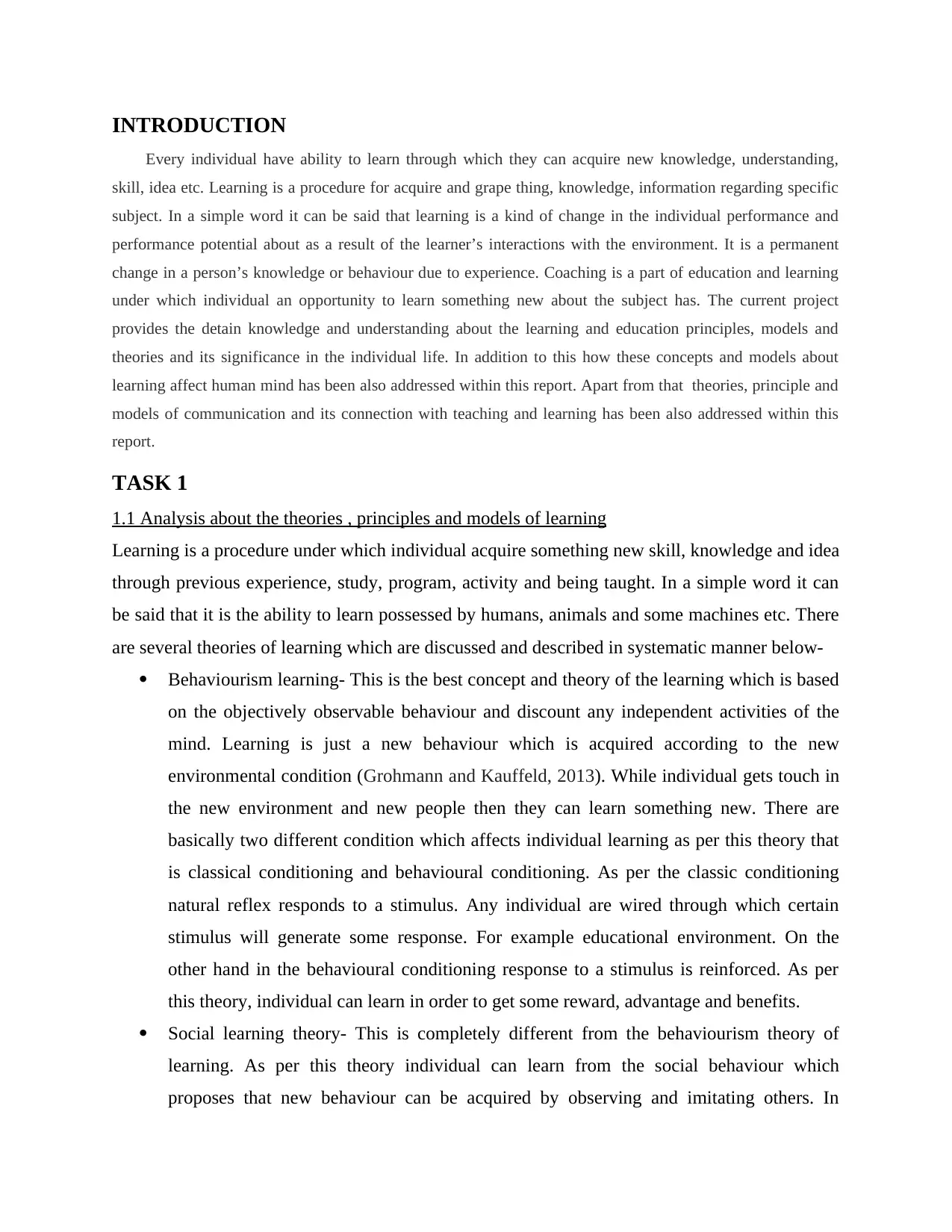
INTRODUCTION
Every individual have ability to learn through which they can acquire new knowledge, understanding,
skill, idea etc. Learning is a procedure for acquire and grape thing, knowledge, information regarding specific
subject. In a simple word it can be said that learning is a kind of change in the individual performance and
performance potential about as a result of the learner’s interactions with the environment. It is a permanent
change in a person’s knowledge or behaviour due to experience. Coaching is a part of education and learning
under which individual an opportunity to learn something new about the subject has. The current project
provides the detain knowledge and understanding about the learning and education principles, models and
theories and its significance in the individual life. In addition to this how these concepts and models about
learning affect human mind has been also addressed within this report. Apart from that theories, principle and
models of communication and its connection with teaching and learning has been also addressed within this
report.
TASK 1
1.1 Analysis about the theories , principles and models of learning
Learning is a procedure under which individual acquire something new skill, knowledge and idea
through previous experience, study, program, activity and being taught. In a simple word it can
be said that it is the ability to learn possessed by humans, animals and some machines etc. There
are several theories of learning which are discussed and described in systematic manner below-
Behaviourism learning- This is the best concept and theory of the learning which is based
on the objectively observable behaviour and discount any independent activities of the
mind. Learning is just a new behaviour which is acquired according to the new
environmental condition (Grohmann and Kauffeld, 2013). While individual gets touch in
the new environment and new people then they can learn something new. There are
basically two different condition which affects individual learning as per this theory that
is classical conditioning and behavioural conditioning. As per the classic conditioning
natural reflex responds to a stimulus. Any individual are wired through which certain
stimulus will generate some response. For example educational environment. On the
other hand in the behavioural conditioning response to a stimulus is reinforced. As per
this theory, individual can learn in order to get some reward, advantage and benefits.
Social learning theory- This is completely different from the behaviourism theory of
learning. As per this theory individual can learn from the social behaviour which
proposes that new behaviour can be acquired by observing and imitating others. In
Every individual have ability to learn through which they can acquire new knowledge, understanding,
skill, idea etc. Learning is a procedure for acquire and grape thing, knowledge, information regarding specific
subject. In a simple word it can be said that learning is a kind of change in the individual performance and
performance potential about as a result of the learner’s interactions with the environment. It is a permanent
change in a person’s knowledge or behaviour due to experience. Coaching is a part of education and learning
under which individual an opportunity to learn something new about the subject has. The current project
provides the detain knowledge and understanding about the learning and education principles, models and
theories and its significance in the individual life. In addition to this how these concepts and models about
learning affect human mind has been also addressed within this report. Apart from that theories, principle and
models of communication and its connection with teaching and learning has been also addressed within this
report.
TASK 1
1.1 Analysis about the theories , principles and models of learning
Learning is a procedure under which individual acquire something new skill, knowledge and idea
through previous experience, study, program, activity and being taught. In a simple word it can
be said that it is the ability to learn possessed by humans, animals and some machines etc. There
are several theories of learning which are discussed and described in systematic manner below-
Behaviourism learning- This is the best concept and theory of the learning which is based
on the objectively observable behaviour and discount any independent activities of the
mind. Learning is just a new behaviour which is acquired according to the new
environmental condition (Grohmann and Kauffeld, 2013). While individual gets touch in
the new environment and new people then they can learn something new. There are
basically two different condition which affects individual learning as per this theory that
is classical conditioning and behavioural conditioning. As per the classic conditioning
natural reflex responds to a stimulus. Any individual are wired through which certain
stimulus will generate some response. For example educational environment. On the
other hand in the behavioural conditioning response to a stimulus is reinforced. As per
this theory, individual can learn in order to get some reward, advantage and benefits.
Social learning theory- This is completely different from the behaviourism theory of
learning. As per this theory individual can learn from the social behaviour which
proposes that new behaviour can be acquired by observing and imitating others. In
⊘ This is a preview!⊘
Do you want full access?
Subscribe today to unlock all pages.

Trusted by 1+ million students worldwide
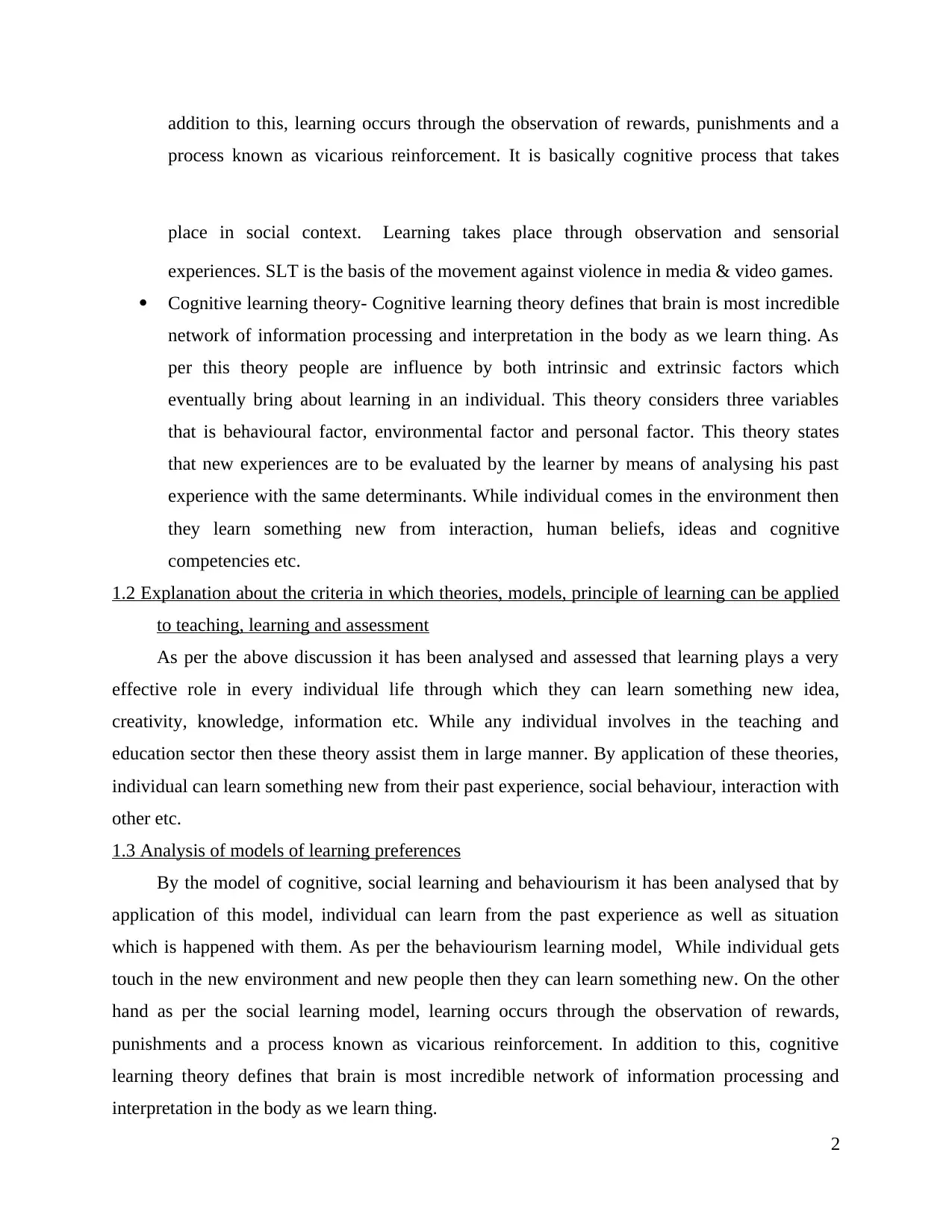
addition to this, learning occurs through the observation of rewards, punishments and a
process known as vicarious reinforcement. It is basically cognitive process that takes
place in social context. Learning takes place through observation and sensorial
experiences. SLT is the basis of the movement against violence in media & video games.
Cognitive learning theory- Cognitive learning theory defines that brain is most incredible
network of information processing and interpretation in the body as we learn thing. As
per this theory people are influence by both intrinsic and extrinsic factors which
eventually bring about learning in an individual. This theory considers three variables
that is behavioural factor, environmental factor and personal factor. This theory states
that new experiences are to be evaluated by the learner by means of analysing his past
experience with the same determinants. While individual comes in the environment then
they learn something new from interaction, human beliefs, ideas and cognitive
competencies etc.
1.2 Explanation about the criteria in which theories, models, principle of learning can be applied
to teaching, learning and assessment
As per the above discussion it has been analysed and assessed that learning plays a very
effective role in every individual life through which they can learn something new idea,
creativity, knowledge, information etc. While any individual involves in the teaching and
education sector then these theory assist them in large manner. By application of these theories,
individual can learn something new from their past experience, social behaviour, interaction with
other etc.
1.3 Analysis of models of learning preferences
By the model of cognitive, social learning and behaviourism it has been analysed that by
application of this model, individual can learn from the past experience as well as situation
which is happened with them. As per the behaviourism learning model, While individual gets
touch in the new environment and new people then they can learn something new. On the other
hand as per the social learning model, learning occurs through the observation of rewards,
punishments and a process known as vicarious reinforcement. In addition to this, cognitive
learning theory defines that brain is most incredible network of information processing and
interpretation in the body as we learn thing.
2
process known as vicarious reinforcement. It is basically cognitive process that takes
place in social context. Learning takes place through observation and sensorial
experiences. SLT is the basis of the movement against violence in media & video games.
Cognitive learning theory- Cognitive learning theory defines that brain is most incredible
network of information processing and interpretation in the body as we learn thing. As
per this theory people are influence by both intrinsic and extrinsic factors which
eventually bring about learning in an individual. This theory considers three variables
that is behavioural factor, environmental factor and personal factor. This theory states
that new experiences are to be evaluated by the learner by means of analysing his past
experience with the same determinants. While individual comes in the environment then
they learn something new from interaction, human beliefs, ideas and cognitive
competencies etc.
1.2 Explanation about the criteria in which theories, models, principle of learning can be applied
to teaching, learning and assessment
As per the above discussion it has been analysed and assessed that learning plays a very
effective role in every individual life through which they can learn something new idea,
creativity, knowledge, information etc. While any individual involves in the teaching and
education sector then these theory assist them in large manner. By application of these theories,
individual can learn something new from their past experience, social behaviour, interaction with
other etc.
1.3 Analysis of models of learning preferences
By the model of cognitive, social learning and behaviourism it has been analysed that by
application of this model, individual can learn from the past experience as well as situation
which is happened with them. As per the behaviourism learning model, While individual gets
touch in the new environment and new people then they can learn something new. On the other
hand as per the social learning model, learning occurs through the observation of rewards,
punishments and a process known as vicarious reinforcement. In addition to this, cognitive
learning theory defines that brain is most incredible network of information processing and
interpretation in the body as we learn thing.
2
Paraphrase This Document
Need a fresh take? Get an instant paraphrase of this document with our AI Paraphraser
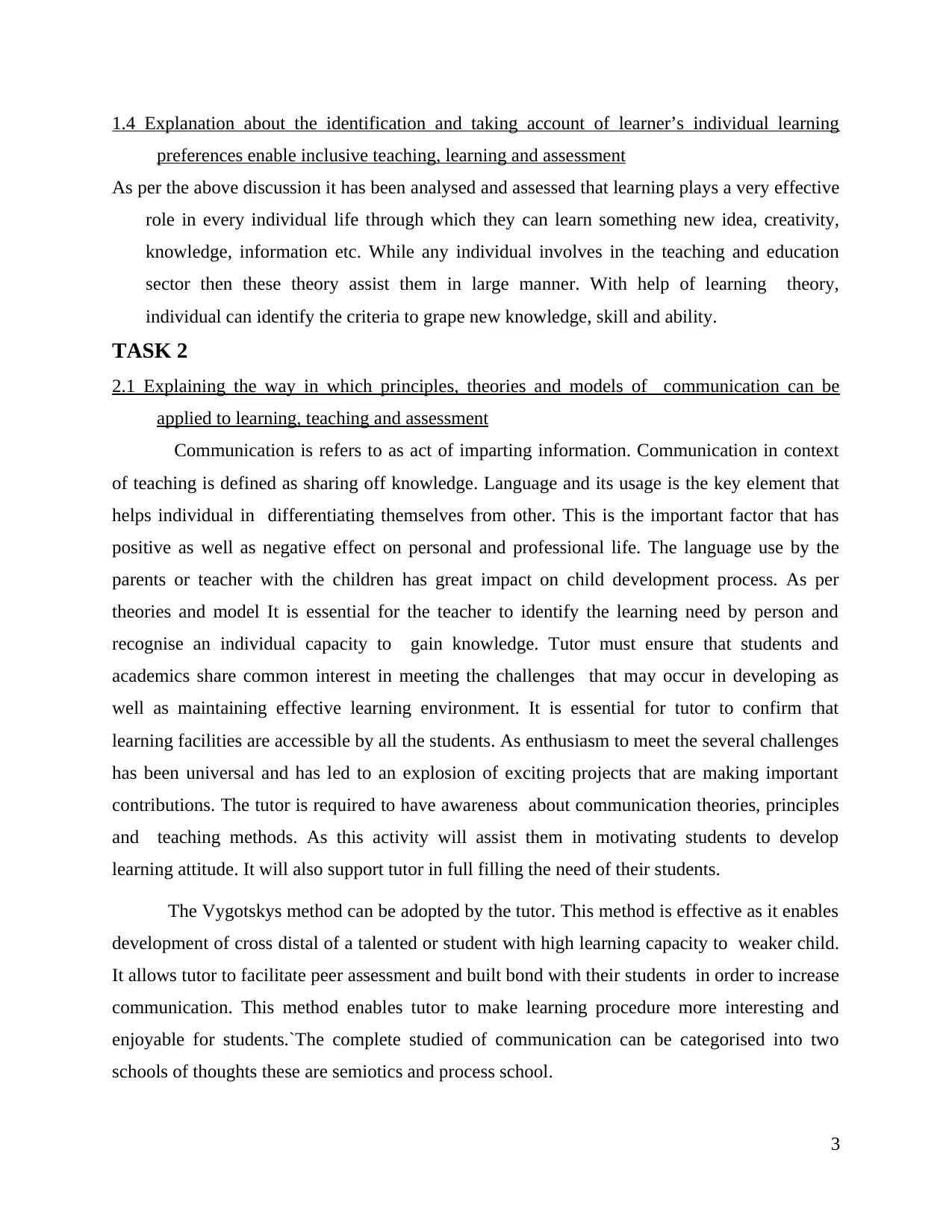
1.4 Explanation about the identification and taking account of learner’s individual learning
preferences enable inclusive teaching, learning and assessment
As per the above discussion it has been analysed and assessed that learning plays a very effective
role in every individual life through which they can learn something new idea, creativity,
knowledge, information etc. While any individual involves in the teaching and education
sector then these theory assist them in large manner. With help of learning theory,
individual can identify the criteria to grape new knowledge, skill and ability.
TASK 2
2.1 Explaining the way in which principles, theories and models of communication can be
applied to learning, teaching and assessment
Communication is refers to as act of imparting information. Communication in context
of teaching is defined as sharing off knowledge. Language and its usage is the key element that
helps individual in differentiating themselves from other. This is the important factor that has
positive as well as negative effect on personal and professional life. The language use by the
parents or teacher with the children has great impact on child development process. As per
theories and model It is essential for the teacher to identify the learning need by person and
recognise an individual capacity to gain knowledge. Tutor must ensure that students and
academics share common interest in meeting the challenges that may occur in developing as
well as maintaining effective learning environment. It is essential for tutor to confirm that
learning facilities are accessible by all the students. As enthusiasm to meet the several challenges
has been universal and has led to an explosion of exciting projects that are making important
contributions. The tutor is required to have awareness about communication theories, principles
and teaching methods. As this activity will assist them in motivating students to develop
learning attitude. It will also support tutor in full filling the need of their students.
The Vygotskys method can be adopted by the tutor. This method is effective as it enables
development of cross distal of a talented or student with high learning capacity to weaker child.
It allows tutor to facilitate peer assessment and built bond with their students in order to increase
communication. This method enables tutor to make learning procedure more interesting and
enjoyable for students.`The complete studied of communication can be categorised into two
schools of thoughts these are semiotics and process school.
3
preferences enable inclusive teaching, learning and assessment
As per the above discussion it has been analysed and assessed that learning plays a very effective
role in every individual life through which they can learn something new idea, creativity,
knowledge, information etc. While any individual involves in the teaching and education
sector then these theory assist them in large manner. With help of learning theory,
individual can identify the criteria to grape new knowledge, skill and ability.
TASK 2
2.1 Explaining the way in which principles, theories and models of communication can be
applied to learning, teaching and assessment
Communication is refers to as act of imparting information. Communication in context
of teaching is defined as sharing off knowledge. Language and its usage is the key element that
helps individual in differentiating themselves from other. This is the important factor that has
positive as well as negative effect on personal and professional life. The language use by the
parents or teacher with the children has great impact on child development process. As per
theories and model It is essential for the teacher to identify the learning need by person and
recognise an individual capacity to gain knowledge. Tutor must ensure that students and
academics share common interest in meeting the challenges that may occur in developing as
well as maintaining effective learning environment. It is essential for tutor to confirm that
learning facilities are accessible by all the students. As enthusiasm to meet the several challenges
has been universal and has led to an explosion of exciting projects that are making important
contributions. The tutor is required to have awareness about communication theories, principles
and teaching methods. As this activity will assist them in motivating students to develop
learning attitude. It will also support tutor in full filling the need of their students.
The Vygotskys method can be adopted by the tutor. This method is effective as it enables
development of cross distal of a talented or student with high learning capacity to weaker child.
It allows tutor to facilitate peer assessment and built bond with their students in order to increase
communication. This method enables tutor to make learning procedure more interesting and
enjoyable for students.`The complete studied of communication can be categorised into two
schools of thoughts these are semiotics and process school.
3
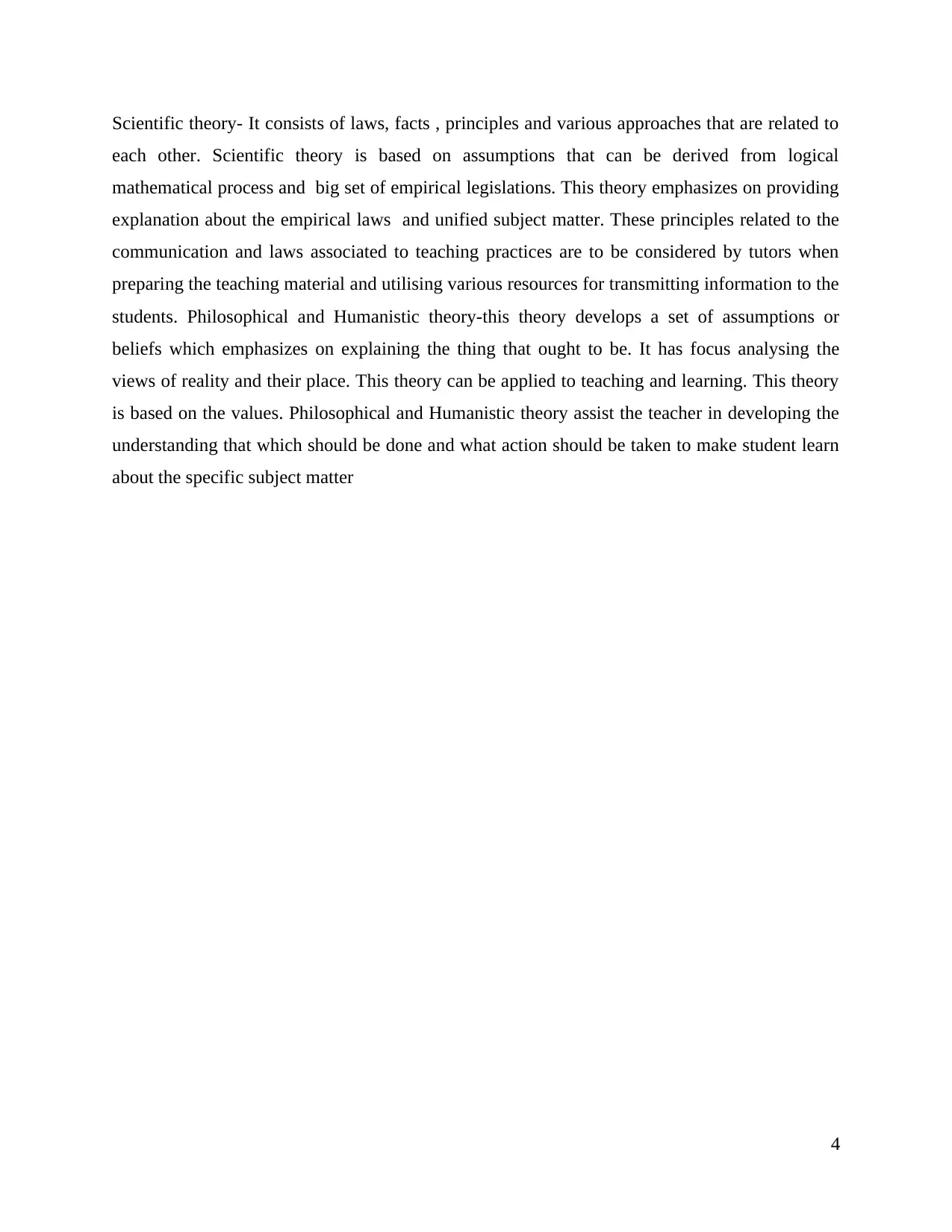
Scientific theory- It consists of laws, facts , principles and various approaches that are related to
each other. Scientific theory is based on assumptions that can be derived from logical
mathematical process and big set of empirical legislations. This theory emphasizes on providing
explanation about the empirical laws and unified subject matter. These principles related to the
communication and laws associated to teaching practices are to be considered by tutors when
preparing the teaching material and utilising various resources for transmitting information to the
students. Philosophical and Humanistic theory-this theory develops a set of assumptions or
beliefs which emphasizes on explaining the thing that ought to be. It has focus analysing the
views of reality and their place. This theory can be applied to teaching and learning. This theory
is based on the values. Philosophical and Humanistic theory assist the teacher in developing the
understanding that which should be done and what action should be taken to make student learn
about the specific subject matter
4
each other. Scientific theory is based on assumptions that can be derived from logical
mathematical process and big set of empirical legislations. This theory emphasizes on providing
explanation about the empirical laws and unified subject matter. These principles related to the
communication and laws associated to teaching practices are to be considered by tutors when
preparing the teaching material and utilising various resources for transmitting information to the
students. Philosophical and Humanistic theory-this theory develops a set of assumptions or
beliefs which emphasizes on explaining the thing that ought to be. It has focus analysing the
views of reality and their place. This theory can be applied to teaching and learning. This theory
is based on the values. Philosophical and Humanistic theory assist the teacher in developing the
understanding that which should be done and what action should be taken to make student learn
about the specific subject matter
4
⊘ This is a preview!⊘
Do you want full access?
Subscribe today to unlock all pages.

Trusted by 1+ million students worldwide
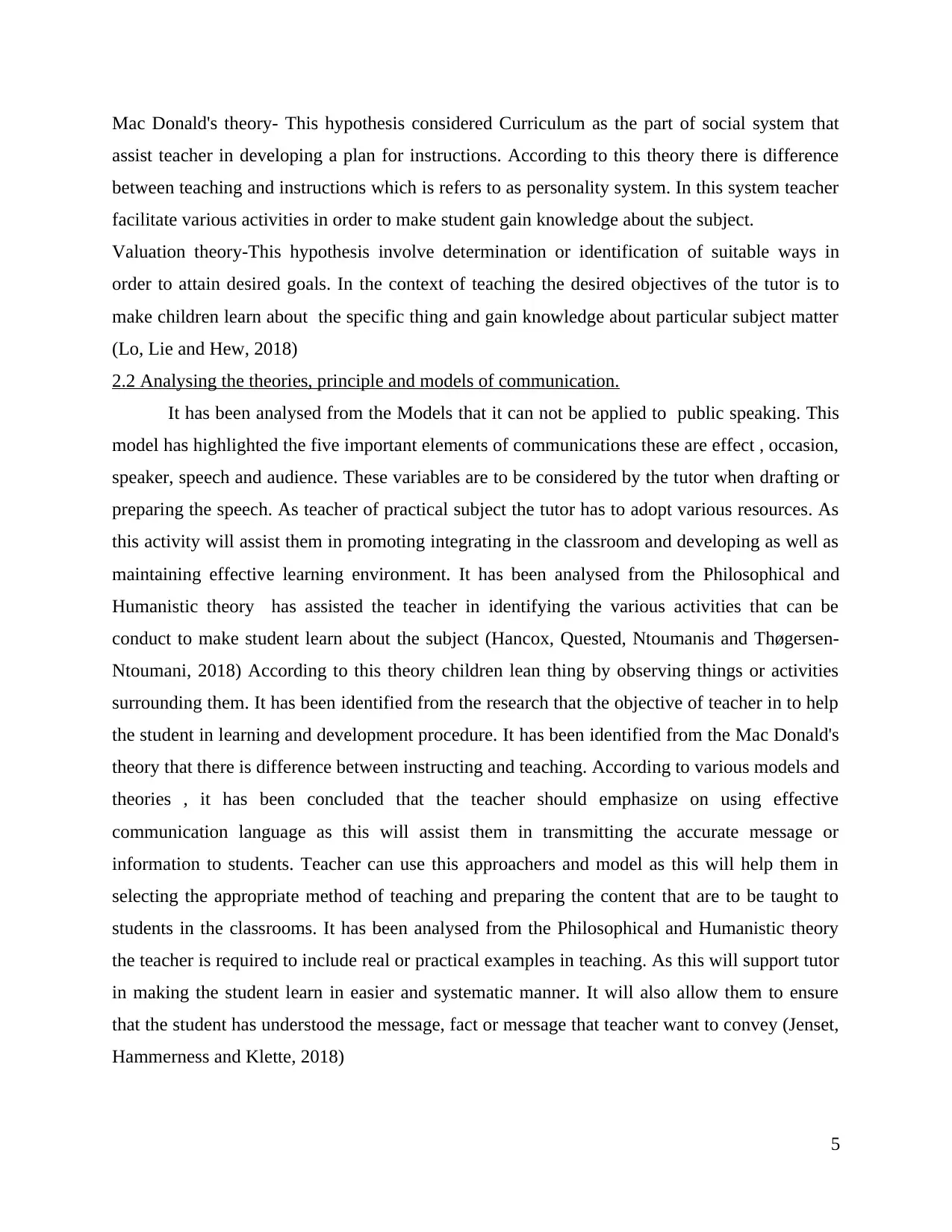
Mac Donald's theory- This hypothesis considered Curriculum as the part of social system that
assist teacher in developing a plan for instructions. According to this theory there is difference
between teaching and instructions which is refers to as personality system. In this system teacher
facilitate various activities in order to make student gain knowledge about the subject.
Valuation theory-This hypothesis involve determination or identification of suitable ways in
order to attain desired goals. In the context of teaching the desired objectives of the tutor is to
make children learn about the specific thing and gain knowledge about particular subject matter
(Lo, Lie and Hew, 2018)
2.2 Analysing the theories, principle and models of communication.
It has been analysed from the Models that it can not be applied to public speaking. This
model has highlighted the five important elements of communications these are effect , occasion,
speaker, speech and audience. These variables are to be considered by the tutor when drafting or
preparing the speech. As teacher of practical subject the tutor has to adopt various resources. As
this activity will assist them in promoting integrating in the classroom and developing as well as
maintaining effective learning environment. It has been analysed from the Philosophical and
Humanistic theory has assisted the teacher in identifying the various activities that can be
conduct to make student learn about the subject (Hancox, Quested, Ntoumanis and Thøgersen-
Ntoumani, 2018) According to this theory children lean thing by observing things or activities
surrounding them. It has been identified from the research that the objective of teacher in to help
the student in learning and development procedure. It has been identified from the Mac Donald's
theory that there is difference between instructing and teaching. According to various models and
theories , it has been concluded that the teacher should emphasize on using effective
communication language as this will assist them in transmitting the accurate message or
information to students. Teacher can use this approachers and model as this will help them in
selecting the appropriate method of teaching and preparing the content that are to be taught to
students in the classrooms. It has been analysed from the Philosophical and Humanistic theory
the teacher is required to include real or practical examples in teaching. As this will support tutor
in making the student learn in easier and systematic manner. It will also allow them to ensure
that the student has understood the message, fact or message that teacher want to convey (Jenset,
Hammerness and Klette, 2018)
5
assist teacher in developing a plan for instructions. According to this theory there is difference
between teaching and instructions which is refers to as personality system. In this system teacher
facilitate various activities in order to make student gain knowledge about the subject.
Valuation theory-This hypothesis involve determination or identification of suitable ways in
order to attain desired goals. In the context of teaching the desired objectives of the tutor is to
make children learn about the specific thing and gain knowledge about particular subject matter
(Lo, Lie and Hew, 2018)
2.2 Analysing the theories, principle and models of communication.
It has been analysed from the Models that it can not be applied to public speaking. This
model has highlighted the five important elements of communications these are effect , occasion,
speaker, speech and audience. These variables are to be considered by the tutor when drafting or
preparing the speech. As teacher of practical subject the tutor has to adopt various resources. As
this activity will assist them in promoting integrating in the classroom and developing as well as
maintaining effective learning environment. It has been analysed from the Philosophical and
Humanistic theory has assisted the teacher in identifying the various activities that can be
conduct to make student learn about the subject (Hancox, Quested, Ntoumanis and Thøgersen-
Ntoumani, 2018) According to this theory children lean thing by observing things or activities
surrounding them. It has been identified from the research that the objective of teacher in to help
the student in learning and development procedure. It has been identified from the Mac Donald's
theory that there is difference between instructing and teaching. According to various models and
theories , it has been concluded that the teacher should emphasize on using effective
communication language as this will assist them in transmitting the accurate message or
information to students. Teacher can use this approachers and model as this will help them in
selecting the appropriate method of teaching and preparing the content that are to be taught to
students in the classrooms. It has been analysed from the Philosophical and Humanistic theory
the teacher is required to include real or practical examples in teaching. As this will support tutor
in making the student learn in easier and systematic manner. It will also allow them to ensure
that the student has understood the message, fact or message that teacher want to convey (Jenset,
Hammerness and Klette, 2018)
5
Paraphrase This Document
Need a fresh take? Get an instant paraphrase of this document with our AI Paraphraser
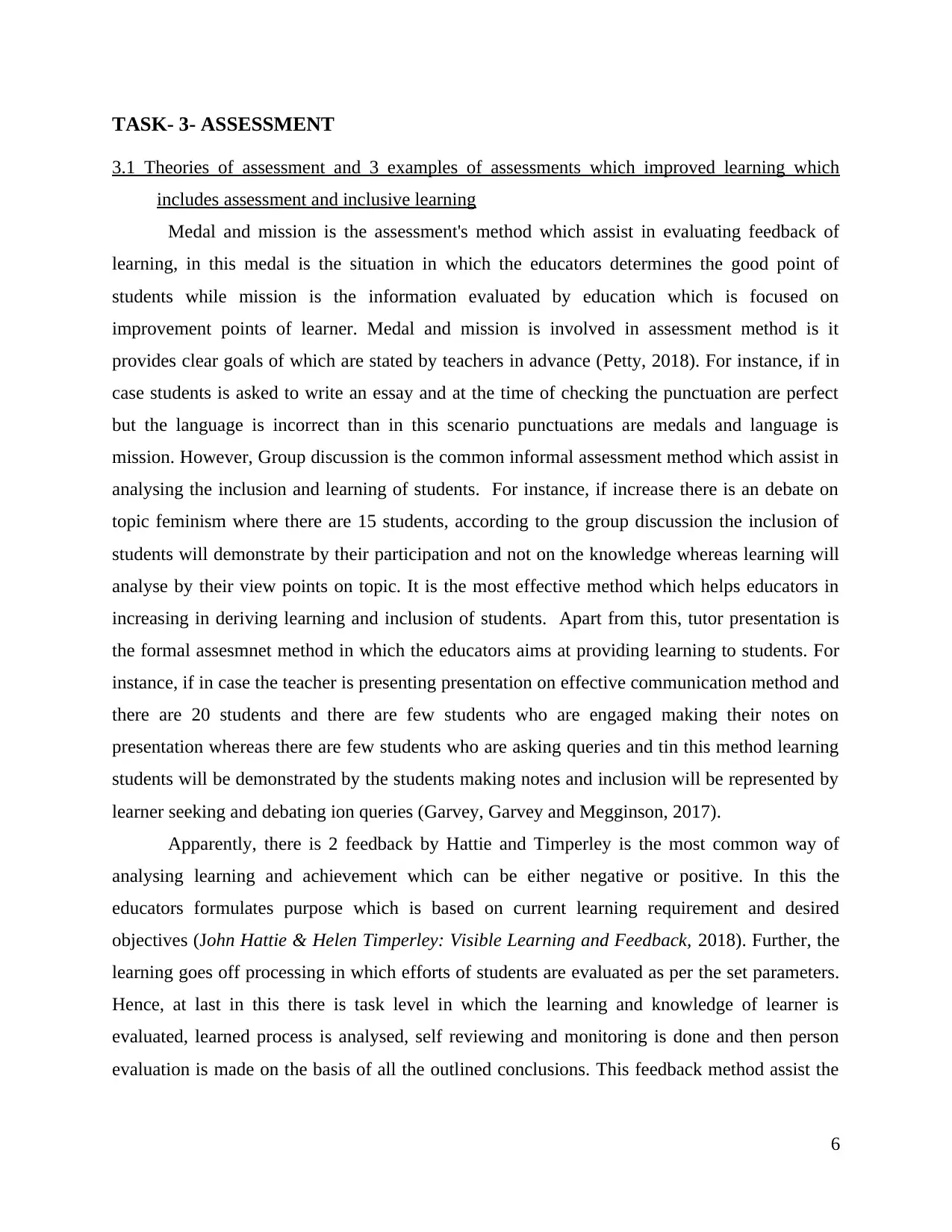
TASK- 3- ASSESSMENT
3.1 Theories of assessment and 3 examples of assessments which improved learning which
includes assessment and inclusive learning
Medal and mission is the assessment's method which assist in evaluating feedback of
learning, in this medal is the situation in which the educators determines the good point of
students while mission is the information evaluated by education which is focused on
improvement points of learner. Medal and mission is involved in assessment method is it
provides clear goals of which are stated by teachers in advance (Petty, 2018). For instance, if in
case students is asked to write an essay and at the time of checking the punctuation are perfect
but the language is incorrect than in this scenario punctuations are medals and language is
mission. However, Group discussion is the common informal assessment method which assist in
analysing the inclusion and learning of students. For instance, if increase there is an debate on
topic feminism where there are 15 students, according to the group discussion the inclusion of
students will demonstrate by their participation and not on the knowledge whereas learning will
analyse by their view points on topic. It is the most effective method which helps educators in
increasing in deriving learning and inclusion of students. Apart from this, tutor presentation is
the formal assesmnet method in which the educators aims at providing learning to students. For
instance, if in case the teacher is presenting presentation on effective communication method and
there are 20 students and there are few students who are engaged making their notes on
presentation whereas there are few students who are asking queries and tin this method learning
students will be demonstrated by the students making notes and inclusion will be represented by
learner seeking and debating ion queries (Garvey, Garvey and Megginson, 2017).
Apparently, there is 2 feedback by Hattie and Timperley is the most common way of
analysing learning and achievement which can be either negative or positive. In this the
educators formulates purpose which is based on current learning requirement and desired
objectives (John Hattie & Helen Timperley: Visible Learning and Feedback, 2018). Further, the
learning goes off processing in which efforts of students are evaluated as per the set parameters.
Hence, at last in this there is task level in which the learning and knowledge of learner is
evaluated, learned process is analysed, self reviewing and monitoring is done and then person
evaluation is made on the basis of all the outlined conclusions. This feedback method assist the
6
3.1 Theories of assessment and 3 examples of assessments which improved learning which
includes assessment and inclusive learning
Medal and mission is the assessment's method which assist in evaluating feedback of
learning, in this medal is the situation in which the educators determines the good point of
students while mission is the information evaluated by education which is focused on
improvement points of learner. Medal and mission is involved in assessment method is it
provides clear goals of which are stated by teachers in advance (Petty, 2018). For instance, if in
case students is asked to write an essay and at the time of checking the punctuation are perfect
but the language is incorrect than in this scenario punctuations are medals and language is
mission. However, Group discussion is the common informal assessment method which assist in
analysing the inclusion and learning of students. For instance, if increase there is an debate on
topic feminism where there are 15 students, according to the group discussion the inclusion of
students will demonstrate by their participation and not on the knowledge whereas learning will
analyse by their view points on topic. It is the most effective method which helps educators in
increasing in deriving learning and inclusion of students. Apart from this, tutor presentation is
the formal assesmnet method in which the educators aims at providing learning to students. For
instance, if in case the teacher is presenting presentation on effective communication method and
there are 20 students and there are few students who are engaged making their notes on
presentation whereas there are few students who are asking queries and tin this method learning
students will be demonstrated by the students making notes and inclusion will be represented by
learner seeking and debating ion queries (Garvey, Garvey and Megginson, 2017).
Apparently, there is 2 feedback by Hattie and Timperley is the most common way of
analysing learning and achievement which can be either negative or positive. In this the
educators formulates purpose which is based on current learning requirement and desired
objectives (John Hattie & Helen Timperley: Visible Learning and Feedback, 2018). Further, the
learning goes off processing in which efforts of students are evaluated as per the set parameters.
Hence, at last in this there is task level in which the learning and knowledge of learner is
evaluated, learned process is analysed, self reviewing and monitoring is done and then person
evaluation is made on the basis of all the outlined conclusions. This feedback method assist the
6
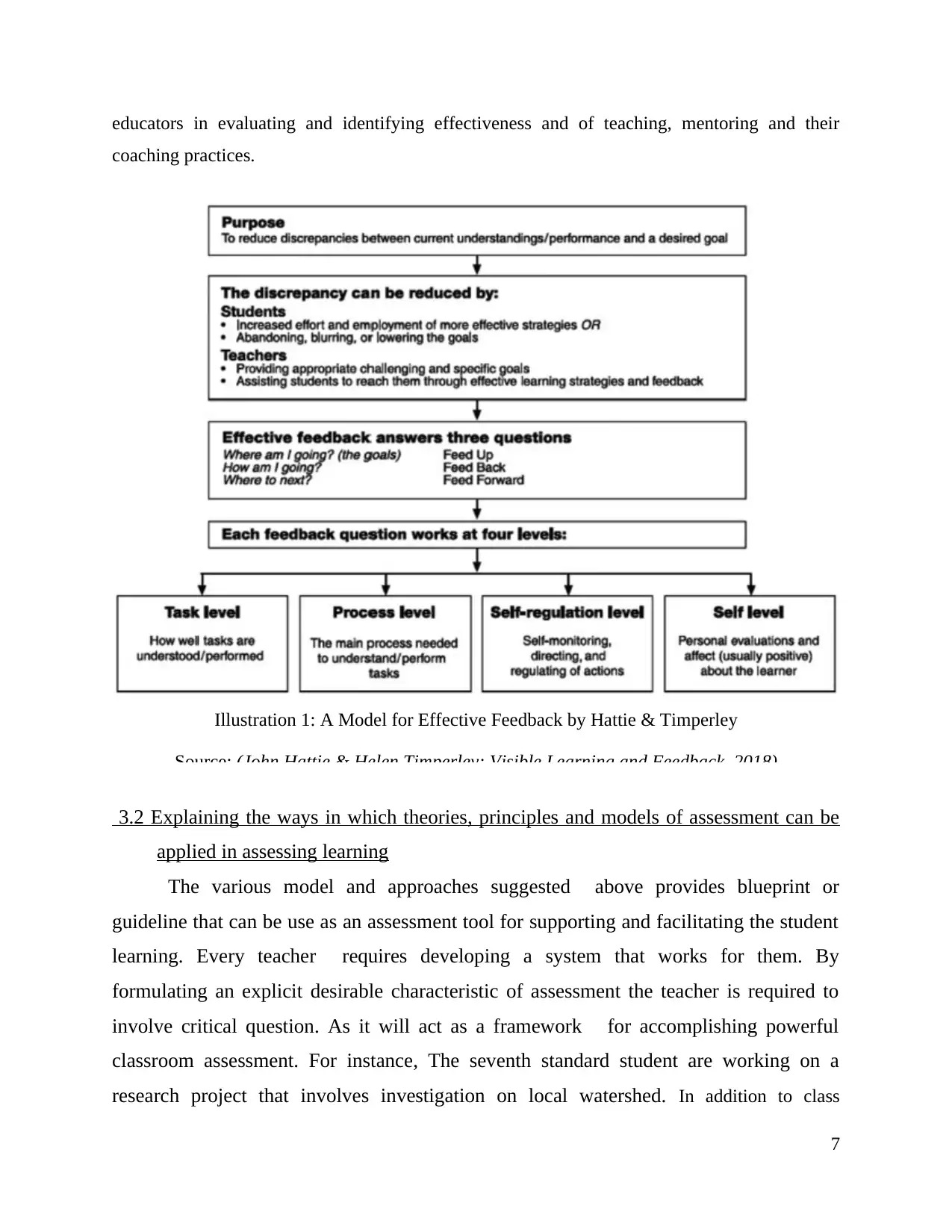
educators in evaluating and identifying effectiveness and of teaching, mentoring and their
coaching practices.
3.2 Explaining the ways in which theories, principles and models of assessment can be
applied in assessing learning
The various model and approaches suggested above provides blueprint or
guideline that can be use as an assessment tool for supporting and facilitating the student
learning. Every teacher requires developing a system that works for them. By
formulating an explicit desirable characteristic of assessment the teacher is required to
involve critical question. As it will act as a framework for accomplishing powerful
classroom assessment. For instance, The seventh standard student are working on a
research project that involves investigation on local watershed. In addition to class
7
Illustration 1: A Model for Effective Feedback by Hattie & Timperley
Source: (John Hattie & Helen Timperley: Visible Learning and Feedback, 2018)
coaching practices.
3.2 Explaining the ways in which theories, principles and models of assessment can be
applied in assessing learning
The various model and approaches suggested above provides blueprint or
guideline that can be use as an assessment tool for supporting and facilitating the student
learning. Every teacher requires developing a system that works for them. By
formulating an explicit desirable characteristic of assessment the teacher is required to
involve critical question. As it will act as a framework for accomplishing powerful
classroom assessment. For instance, The seventh standard student are working on a
research project that involves investigation on local watershed. In addition to class
7
Illustration 1: A Model for Effective Feedback by Hattie & Timperley
Source: (John Hattie & Helen Timperley: Visible Learning and Feedback, 2018)
⊘ This is a preview!⊘
Do you want full access?
Subscribe today to unlock all pages.

Trusted by 1+ million students worldwide
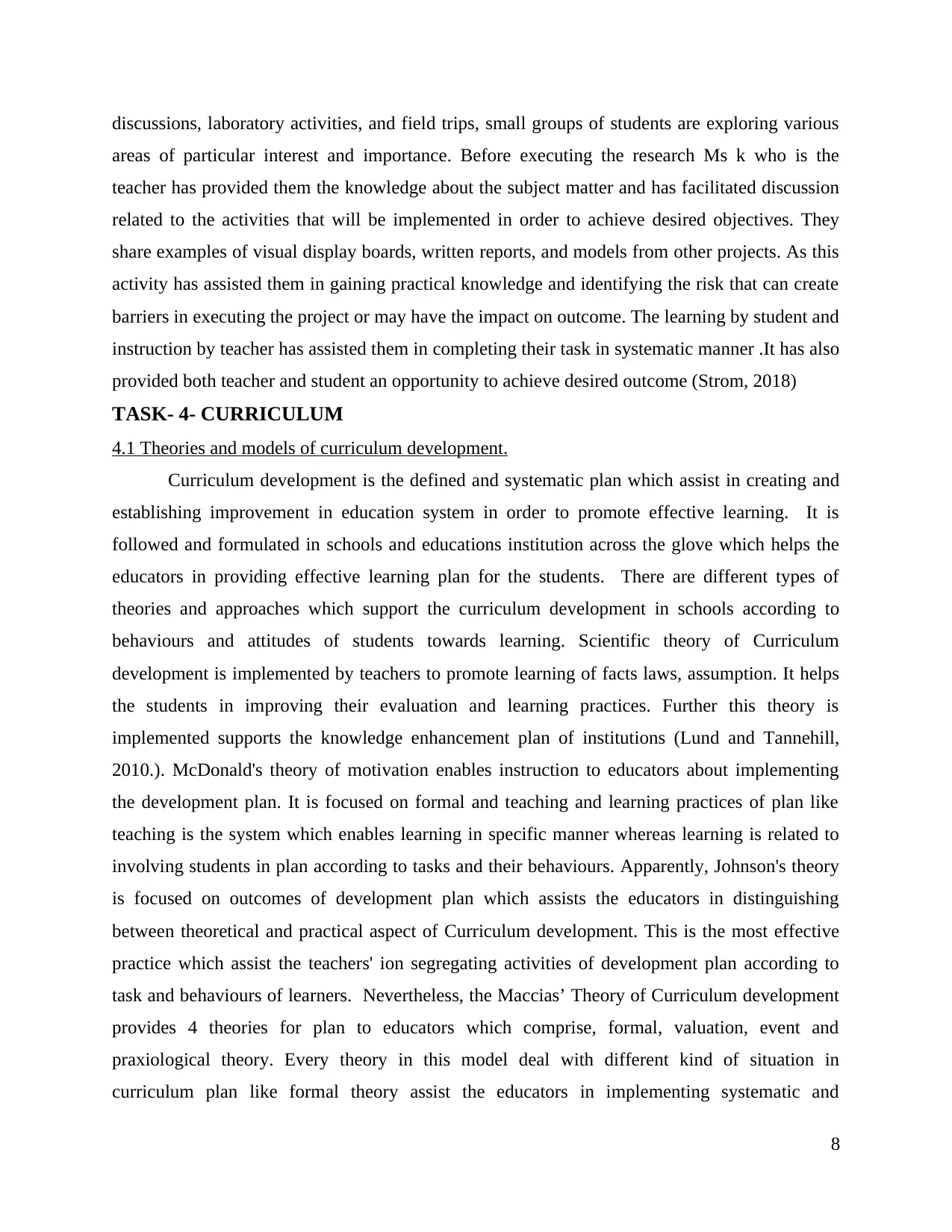
discussions, laboratory activities, and field trips, small groups of students are exploring various
areas of particular interest and importance. Before executing the research Ms k who is the
teacher has provided them the knowledge about the subject matter and has facilitated discussion
related to the activities that will be implemented in order to achieve desired objectives. They
share examples of visual display boards, written reports, and models from other projects. As this
activity has assisted them in gaining practical knowledge and identifying the risk that can create
barriers in executing the project or may have the impact on outcome. The learning by student and
instruction by teacher has assisted them in completing their task in systematic manner .It has also
provided both teacher and student an opportunity to achieve desired outcome (Strom, 2018)
TASK- 4- CURRICULUM
4.1 Theories and models of curriculum development.
Curriculum development is the defined and systematic plan which assist in creating and
establishing improvement in education system in order to promote effective learning. It is
followed and formulated in schools and educations institution across the glove which helps the
educators in providing effective learning plan for the students. There are different types of
theories and approaches which support the curriculum development in schools according to
behaviours and attitudes of students towards learning. Scientific theory of Curriculum
development is implemented by teachers to promote learning of facts laws, assumption. It helps
the students in improving their evaluation and learning practices. Further this theory is
implemented supports the knowledge enhancement plan of institutions (Lund and Tannehill,
2010.). McDonald's theory of motivation enables instruction to educators about implementing
the development plan. It is focused on formal and teaching and learning practices of plan like
teaching is the system which enables learning in specific manner whereas learning is related to
involving students in plan according to tasks and their behaviours. Apparently, Johnson's theory
is focused on outcomes of development plan which assists the educators in distinguishing
between theoretical and practical aspect of Curriculum development. This is the most effective
practice which assist the teachers' ion segregating activities of development plan according to
task and behaviours of learners. Nevertheless, the Maccias’ Theory of Curriculum development
provides 4 theories for plan to educators which comprise, formal, valuation, event and
praxiological theory. Every theory in this model deal with different kind of situation in
curriculum plan like formal theory assist the educators in implementing systematic and
8
areas of particular interest and importance. Before executing the research Ms k who is the
teacher has provided them the knowledge about the subject matter and has facilitated discussion
related to the activities that will be implemented in order to achieve desired objectives. They
share examples of visual display boards, written reports, and models from other projects. As this
activity has assisted them in gaining practical knowledge and identifying the risk that can create
barriers in executing the project or may have the impact on outcome. The learning by student and
instruction by teacher has assisted them in completing their task in systematic manner .It has also
provided both teacher and student an opportunity to achieve desired outcome (Strom, 2018)
TASK- 4- CURRICULUM
4.1 Theories and models of curriculum development.
Curriculum development is the defined and systematic plan which assist in creating and
establishing improvement in education system in order to promote effective learning. It is
followed and formulated in schools and educations institution across the glove which helps the
educators in providing effective learning plan for the students. There are different types of
theories and approaches which support the curriculum development in schools according to
behaviours and attitudes of students towards learning. Scientific theory of Curriculum
development is implemented by teachers to promote learning of facts laws, assumption. It helps
the students in improving their evaluation and learning practices. Further this theory is
implemented supports the knowledge enhancement plan of institutions (Lund and Tannehill,
2010.). McDonald's theory of motivation enables instruction to educators about implementing
the development plan. It is focused on formal and teaching and learning practices of plan like
teaching is the system which enables learning in specific manner whereas learning is related to
involving students in plan according to tasks and their behaviours. Apparently, Johnson's theory
is focused on outcomes of development plan which assists the educators in distinguishing
between theoretical and practical aspect of Curriculum development. This is the most effective
practice which assist the teachers' ion segregating activities of development plan according to
task and behaviours of learners. Nevertheless, the Maccias’ Theory of Curriculum development
provides 4 theories for plan to educators which comprise, formal, valuation, event and
praxiological theory. Every theory in this model deal with different kind of situation in
curriculum plan like formal theory assist the educators in implementing systematic and
8
Paraphrase This Document
Need a fresh take? Get an instant paraphrase of this document with our AI Paraphraser
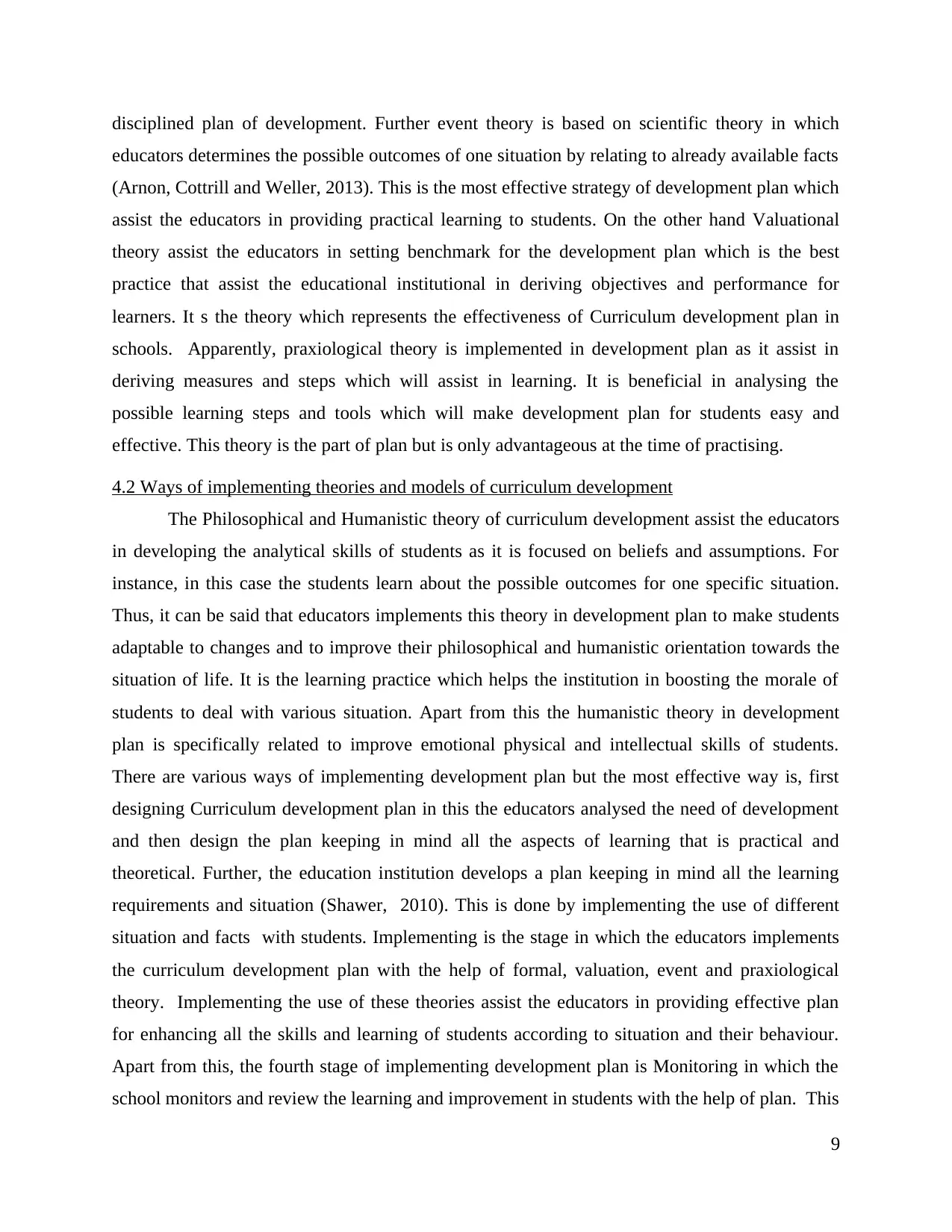
disciplined plan of development. Further event theory is based on scientific theory in which
educators determines the possible outcomes of one situation by relating to already available facts
(Arnon, Cottrill and Weller, 2013). This is the most effective strategy of development plan which
assist the educators in providing practical learning to students. On the other hand Valuational
theory assist the educators in setting benchmark for the development plan which is the best
practice that assist the educational institutional in deriving objectives and performance for
learners. It s the theory which represents the effectiveness of Curriculum development plan in
schools. Apparently, praxiological theory is implemented in development plan as it assist in
deriving measures and steps which will assist in learning. It is beneficial in analysing the
possible learning steps and tools which will make development plan for students easy and
effective. This theory is the part of plan but is only advantageous at the time of practising.
4.2 Ways of implementing theories and models of curriculum development
The Philosophical and Humanistic theory of curriculum development assist the educators
in developing the analytical skills of students as it is focused on beliefs and assumptions. For
instance, in this case the students learn about the possible outcomes for one specific situation.
Thus, it can be said that educators implements this theory in development plan to make students
adaptable to changes and to improve their philosophical and humanistic orientation towards the
situation of life. It is the learning practice which helps the institution in boosting the morale of
students to deal with various situation. Apart from this the humanistic theory in development
plan is specifically related to improve emotional physical and intellectual skills of students.
There are various ways of implementing development plan but the most effective way is, first
designing Curriculum development plan in this the educators analysed the need of development
and then design the plan keeping in mind all the aspects of learning that is practical and
theoretical. Further, the education institution develops a plan keeping in mind all the learning
requirements and situation (Shawer, 2010). This is done by implementing the use of different
situation and facts with students. Implementing is the stage in which the educators implements
the curriculum development plan with the help of formal, valuation, event and praxiological
theory. Implementing the use of these theories assist the educators in providing effective plan
for enhancing all the skills and learning of students according to situation and their behaviour.
Apart from this, the fourth stage of implementing development plan is Monitoring in which the
school monitors and review the learning and improvement in students with the help of plan. This
9
educators determines the possible outcomes of one situation by relating to already available facts
(Arnon, Cottrill and Weller, 2013). This is the most effective strategy of development plan which
assist the educators in providing practical learning to students. On the other hand Valuational
theory assist the educators in setting benchmark for the development plan which is the best
practice that assist the educational institutional in deriving objectives and performance for
learners. It s the theory which represents the effectiveness of Curriculum development plan in
schools. Apparently, praxiological theory is implemented in development plan as it assist in
deriving measures and steps which will assist in learning. It is beneficial in analysing the
possible learning steps and tools which will make development plan for students easy and
effective. This theory is the part of plan but is only advantageous at the time of practising.
4.2 Ways of implementing theories and models of curriculum development
The Philosophical and Humanistic theory of curriculum development assist the educators
in developing the analytical skills of students as it is focused on beliefs and assumptions. For
instance, in this case the students learn about the possible outcomes for one specific situation.
Thus, it can be said that educators implements this theory in development plan to make students
adaptable to changes and to improve their philosophical and humanistic orientation towards the
situation of life. It is the learning practice which helps the institution in boosting the morale of
students to deal with various situation. Apart from this the humanistic theory in development
plan is specifically related to improve emotional physical and intellectual skills of students.
There are various ways of implementing development plan but the most effective way is, first
designing Curriculum development plan in this the educators analysed the need of development
and then design the plan keeping in mind all the aspects of learning that is practical and
theoretical. Further, the education institution develops a plan keeping in mind all the learning
requirements and situation (Shawer, 2010). This is done by implementing the use of different
situation and facts with students. Implementing is the stage in which the educators implements
the curriculum development plan with the help of formal, valuation, event and praxiological
theory. Implementing the use of these theories assist the educators in providing effective plan
for enhancing all the skills and learning of students according to situation and their behaviour.
Apart from this, the fourth stage of implementing development plan is Monitoring in which the
school monitors and review the learning and improvement in students with the help of plan. This
9
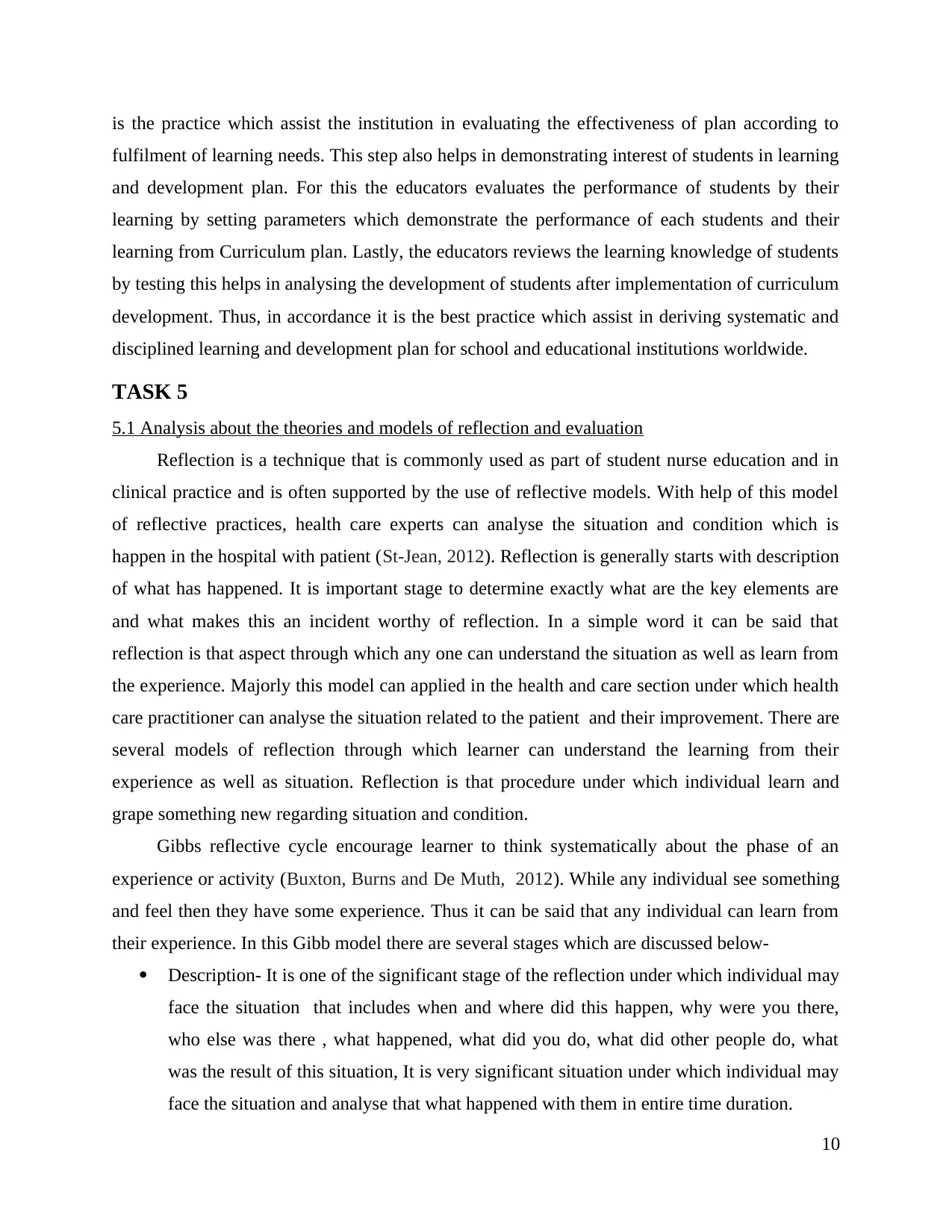
is the practice which assist the institution in evaluating the effectiveness of plan according to
fulfilment of learning needs. This step also helps in demonstrating interest of students in learning
and development plan. For this the educators evaluates the performance of students by their
learning by setting parameters which demonstrate the performance of each students and their
learning from Curriculum plan. Lastly, the educators reviews the learning knowledge of students
by testing this helps in analysing the development of students after implementation of curriculum
development. Thus, in accordance it is the best practice which assist in deriving systematic and
disciplined learning and development plan for school and educational institutions worldwide.
TASK 5
5.1 Analysis about the theories and models of reflection and evaluation
Reflection is a technique that is commonly used as part of student nurse education and in
clinical practice and is often supported by the use of reflective models. With help of this model
of reflective practices, health care experts can analyse the situation and condition which is
happen in the hospital with patient (St‐Jean, 2012). Reflection is generally starts with description
of what has happened. It is important stage to determine exactly what are the key elements are
and what makes this an incident worthy of reflection. In a simple word it can be said that
reflection is that aspect through which any one can understand the situation as well as learn from
the experience. Majorly this model can applied in the health and care section under which health
care practitioner can analyse the situation related to the patient and their improvement. There are
several models of reflection through which learner can understand the learning from their
experience as well as situation. Reflection is that procedure under which individual learn and
grape something new regarding situation and condition.
Gibbs reflective cycle encourage learner to think systematically about the phase of an
experience or activity (Buxton, Burns and De Muth, 2012). While any individual see something
and feel then they have some experience. Thus it can be said that any individual can learn from
their experience. In this Gibb model there are several stages which are discussed below-
Description- It is one of the significant stage of the reflection under which individual may
face the situation that includes when and where did this happen, why were you there,
who else was there , what happened, what did you do, what did other people do, what
was the result of this situation, It is very significant situation under which individual may
face the situation and analyse that what happened with them in entire time duration.
10
fulfilment of learning needs. This step also helps in demonstrating interest of students in learning
and development plan. For this the educators evaluates the performance of students by their
learning by setting parameters which demonstrate the performance of each students and their
learning from Curriculum plan. Lastly, the educators reviews the learning knowledge of students
by testing this helps in analysing the development of students after implementation of curriculum
development. Thus, in accordance it is the best practice which assist in deriving systematic and
disciplined learning and development plan for school and educational institutions worldwide.
TASK 5
5.1 Analysis about the theories and models of reflection and evaluation
Reflection is a technique that is commonly used as part of student nurse education and in
clinical practice and is often supported by the use of reflective models. With help of this model
of reflective practices, health care experts can analyse the situation and condition which is
happen in the hospital with patient (St‐Jean, 2012). Reflection is generally starts with description
of what has happened. It is important stage to determine exactly what are the key elements are
and what makes this an incident worthy of reflection. In a simple word it can be said that
reflection is that aspect through which any one can understand the situation as well as learn from
the experience. Majorly this model can applied in the health and care section under which health
care practitioner can analyse the situation related to the patient and their improvement. There are
several models of reflection through which learner can understand the learning from their
experience as well as situation. Reflection is that procedure under which individual learn and
grape something new regarding situation and condition.
Gibbs reflective cycle encourage learner to think systematically about the phase of an
experience or activity (Buxton, Burns and De Muth, 2012). While any individual see something
and feel then they have some experience. Thus it can be said that any individual can learn from
their experience. In this Gibb model there are several stages which are discussed below-
Description- It is one of the significant stage of the reflection under which individual may
face the situation that includes when and where did this happen, why were you there,
who else was there , what happened, what did you do, what did other people do, what
was the result of this situation, It is very significant situation under which individual may
face the situation and analyse that what happened with them in entire time duration.
10
⊘ This is a preview!⊘
Do you want full access?
Subscribe today to unlock all pages.

Trusted by 1+ million students worldwide
1 out of 16
Related Documents
Your All-in-One AI-Powered Toolkit for Academic Success.
+13062052269
info@desklib.com
Available 24*7 on WhatsApp / Email
![[object Object]](/_next/static/media/star-bottom.7253800d.svg)
Unlock your academic potential
Copyright © 2020–2025 A2Z Services. All Rights Reserved. Developed and managed by ZUCOL.



